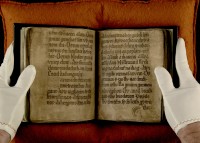 The Black Book of Carmarthen is the oldest surviving manuscript written entirely in the Welsh language. It was penned by a single scribe working at different periods around the year 1250. Its name refers to the color of the binding and to the Augustinian Priory of Saints John the Evangelist and Teulyddog in Carmarthen, west central Wales, which is reputed to have been the manuscript’s original home. It has passed through many hands over the years, several of whom have left their mark on the vellum pages and at least one of whom sought to erase those marks. Now thanks to an ultraviolet lamp and photo editing software, what was lost has been rediscovered.
The Black Book of Carmarthen is the oldest surviving manuscript written entirely in the Welsh language. It was penned by a single scribe working at different periods around the year 1250. Its name refers to the color of the binding and to the Augustinian Priory of Saints John the Evangelist and Teulyddog in Carmarthen, west central Wales, which is reputed to have been the manuscript’s original home. It has passed through many hands over the years, several of whom have left their mark on the vellum pages and at least one of whom sought to erase those marks. Now thanks to an ultraviolet lamp and photo editing software, what was lost has been rediscovered.
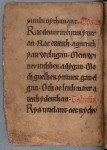 With the exception of a handful of Welsh triads about the legendary horses of Welsh heroes, the contents of the Black Book are poems dating from the 9th to the 12th century. They’re a varied lot, with religious verses, odes of mourning and praise and some of the first written versions of Arthurian tales rubbing shoulders in the 54 folios. The first poem in the book is Ymddiddan Myrddin a Thaliesin (A Conversation Between Merlin and Taliesin), a dialogue between the legendary mage and the great Welsh poet who, like Merlin, was reputed to have the power of prophesy. Two of the pieces later in the manuscript are prophetic poems ostensibly authored by Myrddin during his “wild man” phase.
With the exception of a handful of Welsh triads about the legendary horses of Welsh heroes, the contents of the Black Book are poems dating from the 9th to the 12th century. They’re a varied lot, with religious verses, odes of mourning and praise and some of the first written versions of Arthurian tales rubbing shoulders in the 54 folios. The first poem in the book is Ymddiddan Myrddin a Thaliesin (A Conversation Between Merlin and Taliesin), a dialogue between the legendary mage and the great Welsh poet who, like Merlin, was reputed to have the power of prophesy. Two of the pieces later in the manuscript are prophetic poems ostensibly authored by Myrddin during his “wild man” phase.
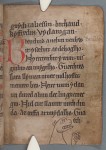 The first owner of the Black Book whose name we know was Sir John Price of Brecon (ca. 1502-1555) who had been tasked by King Henry VIII with searching dissolved monasteries for loot. He got it from the treasurer of St. David’s Cathedral on the westernmost tip of Wales almost 50 miles from Carmarthen which is where he learned of its origins at the priory. It next appears on the historical record in the hands of 17th century Welsh book collector Robert Vaughan, but there are notes on the pages of the book that identify owners between the two. Scholar, book collector and warden of Ruthin Hospital Jasper Gryffyth (d. 1614) wrote his name in Hebrew and a note about the poems on one of the pages. William Salesbury (ca. 1520-1584), polyglot author of a Welsh-English dictionary and translator of the New Testament into Welsh, left a note on the bottom of a page as well. Also, Vaughan wrote in another manuscript that the Black Book had been owned by poet Siôn Tudur (d. 1602) at some point.
The first owner of the Black Book whose name we know was Sir John Price of Brecon (ca. 1502-1555) who had been tasked by King Henry VIII with searching dissolved monasteries for loot. He got it from the treasurer of St. David’s Cathedral on the westernmost tip of Wales almost 50 miles from Carmarthen which is where he learned of its origins at the priory. It next appears on the historical record in the hands of 17th century Welsh book collector Robert Vaughan, but there are notes on the pages of the book that identify owners between the two. Scholar, book collector and warden of Ruthin Hospital Jasper Gryffyth (d. 1614) wrote his name in Hebrew and a note about the poems on one of the pages. William Salesbury (ca. 1520-1584), polyglot author of a Welsh-English dictionary and translator of the New Testament into Welsh, left a note on the bottom of a page as well. Also, Vaughan wrote in another manuscript that the Black Book had been owned by poet Siôn Tudur (d. 1602) at some point.
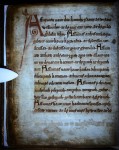 One of those 16th century owners — researchers believe it was probably Jasper Gryffyth — took it upon himself to clean up the Black Book and erase the notes and drawings his predecessors had left in the margins. University of Cambridge PhD student Myriah Williams and Professor Paul Russell noticed there were shadows on some of the pages and thought they might be able to see what was erased using ultraviolet light and playing with the spectrum using photo editing software. They spent three years examining the fragile volume — it’s so delicate can’t be opened at more than a 90 degree angle — and last year found two ghostly faces staring back at them. The little drawings, dated to the 14th or 15th century, were accompanied by an inscription that indicates the book was donated to a family member.
One of those 16th century owners — researchers believe it was probably Jasper Gryffyth — took it upon himself to clean up the Black Book and erase the notes and drawings his predecessors had left in the margins. University of Cambridge PhD student Myriah Williams and Professor Paul Russell noticed there were shadows on some of the pages and thought they might be able to see what was erased using ultraviolet light and playing with the spectrum using photo editing software. They spent three years examining the fragile volume — it’s so delicate can’t be opened at more than a 90 degree angle — and last year found two ghostly faces staring back at them. The little drawings, dated to the 14th or 15th century, were accompanied by an inscription that indicates the book was donated to a family member.
[T]he 16th century owner’s penchant for erasure has been partly reversed to reveal snatches of poetry which are previously unrecorded in the canon of Welsh verse. Currently, the texts are very fragmentary and in need of much more analysis, although they seem to be the continuation of a poem on the preceding page with a new poem added at the foot of the page.
Williams said: “It’s easy to think we know all we can know about a manuscript like the Black Book but to see these ghosts from the past brought back to life in front of our eyes has been incredibly exciting. The drawings and verse that we’re in the process of recovering demonstrate the value of giving these books another look.
“The margins of manuscripts often contain medieval and early modern reactions to the text, and these can cast light on what our ancestors thought about what they were reading. The Black Book was particularly heavily annotated before the end of the 16th century, and the recovery of erasure has much to tell us about what was already there and can change our understanding of it.”
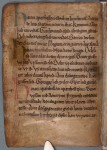 The new poem has no known match in Welsh verse, so it was probably the original work of the annotator. Williams and Russell will give a lecture about their discovery at the National Library of Wales on Wednesday and will emphasize the importance of this research which has the potential to reveal so much about medieval Welsh literature.
The new poem has no known match in Welsh verse, so it was probably the original work of the annotator. Williams and Russell will give a lecture about their discovery at the National Library of Wales on Wednesday and will emphasize the importance of this research which has the potential to reveal so much about medieval Welsh literature.
The National Library of Wales has digitized the entire manuscript. You can browse through it page by page. There are no transcripts or translations, but the notes from previous holders are eminently legible in the first few pages.
Fantastic . Hurrah ! for modern technology
I’ll drink to that.
Weird serendipity. I just watched part of a program about Merlin. They spent a whole part of the story on the Black Book and the stories of Merlin in it.
I can’t wait for the Dan Brown book & Movie that tells me what’s really in the hidden pages of THE BLACK BOOK!
I’m hoping for the Monty Python version, myself.
What a sweet little book. This reinforces my disdain for the “purists” who frown on marginal notes. I love reading other people’s thoughts, even in modern books. I often seek out used books with marginal notes, some not even on the topic. Not only cheaper (that wouldn’t apply to ancient texts, of course) but useful and often entertaining. A new book is boring by comparison until someone (often me) adds a marginal comment. I was so glad when I learned (in high school) that ancient books had them, too, and that scholars cherish them.
I still enjoy looking over my annotations and underscores in book from high school and college. It’s a refresher course in the subject and in my own historical state of mind.
I think we need a tv show that does for history what Jon Stewart did for the news.
Oh my God, I would LOVE that. Then again, given the sad state of history programming at the moment, I’d take anything at all that was done with verve and with a care for accuracy. And no damn reenactments!
Query: “No damn reenactments”?
I hope you mean those “artistically blurred” action sequences of “howling warriors” that seem to populate the history programs concerning anything from stone age cave art to the discovery of people on Papua New Guinea. Those, I can agree with you, are useless and irksome.
But reenactments of how the lost wooden castles of Europe were built? Reenactments and demonstrations of Roman formation marching and wattle-and-daub/thatch repairs? Those I find very helpful as illustrations.
I do mean those ridiculous blurry action sequences. Also the vacuous ladies curtseying and looking at the king suggestively, people eating as grossly as possible and having fake conversations which are conveyed primarily through pointing at stuff.
Recreations are a whole other ball park, a beautiful, wonderful ballpark. We are in complete agreement. :yes: